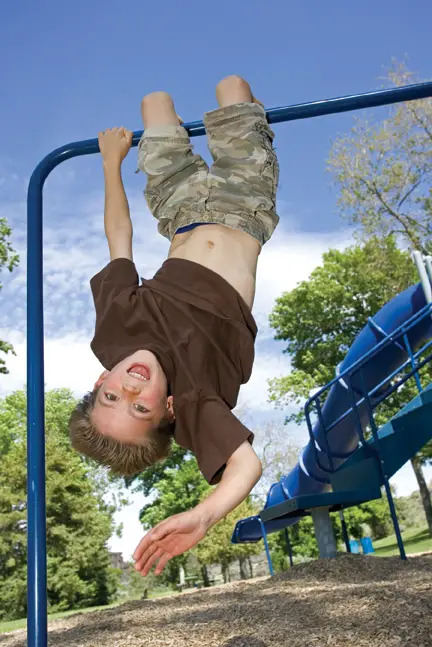It’s natural for parents to want to shield their children from the world’s dangers and to protect them from getting hurt, even when they run around the playground or play sports. But, here’s why it’s healthy for parents to allow children to take risks.
Imagine these scenarios: A toddler ambles along a pebbled path and falls. A 3-year-old starts to climb on top of an uneven rock wall. Two preschoolers have their arms around each other and one wrestles the other to the ground. Would your gut reaction be to run over, swoop up the toddler, and provide comfort? To tell that 3-year-old, “Get down! That’s too dangerous,” or to utter the words “Hands to yourself!” to those two preschoolers?
 Too often these are the reactions from well meaning parents and caregivers. As a society we have become a generation that removes risk from the lives of our children. We have padded playgrounds, low slides, rounded edges, and lists of rules on how not to play. Although it may prevent some scrapes, bumps, and bruises, this overprotective parenting is actually detrimental to the healthy development of our children. Here we will explore how and why it is important to say “Yes!” to these risky activities.
Too often these are the reactions from well meaning parents and caregivers. As a society we have become a generation that removes risk from the lives of our children. We have padded playgrounds, low slides, rounded edges, and lists of rules on how not to play. Although it may prevent some scrapes, bumps, and bruises, this overprotective parenting is actually detrimental to the healthy development of our children. Here we will explore how and why it is important to say “Yes!” to these risky activities.
Keep children as safe as necessary, not as safe as possible.
Let’s consider that toddler who fell on the path. Imagine her falling forward on her hands. Her father is close behind her, but waits. What he is allowing her is the momentary confusion and the time to figure out for herself that she has just fallen, and then to try and pick herself up. She may feel some discomfort, but she is learning that discomfort lessens as she gets up. She is learning that when something unpleasant happens, she has the ability to soothe herself. She is also experiencing the secure feeling of her parent’s confidence in her abilities.
Conversely, if the child falls and the parent immediately swoops in, she doesn’t get to experience what discomfort feels like—and will not have a framework later in life on how to grapple with frustration or distress. These are the children who end up texting their parents from college when the slightest thing goes awry instead of attempting to solve a problem themselves.
What about the child climbing the wall? Should we tell her it is too dangerous and prevent her from even trying? It is good for children to confront their fears in a more relaxed setting. While enjoying adventurous play with her friends, she may follow them up some fairly high rocks. Wanting to be with and please her friends will prompt her to push herself out of her comfort zone and climb those rocks she might otherwise avoid. This feat will allow her to realize that she can be successful—and that it isn’t as frightening of an experience as she initially thought. As children do this their maturity and skill level advance. They are left with a positive feeling of accomplishment that replaces the former fear. If children have overprotective parents or are only allowed to play in super-safe play areas, they do not get to experience these small triumphs, and many end up with anxiety that is inappropriate for their age or skill level.
Outdoor play gives children a sense of adventure, challenges them, and gives them opportunities to develop confidence. If obstacles are always eliminated for them, they do not learn to persist in the face of difficulty. In a 2003 study of outdoor play experiences conducted in New Zealand preschools, a fundamental link was found between a child who is confident tackling physical challenges and one who is confident confronting challenges in other learning contexts. Researchers agree that a willingness to try things out and take risks are important characteristics of effective learners.
Could this child fall or get injured? Yes, but assessing and managing risk is an important life skill. As children learn to navigate their bodies in the world, they will encounter bumps, bruises, and scrapes. Learning to evaluate and handle the risks involved with these physical actions needs to be developed, practiced, and refined. If we remove all possible unsafe situations, we do not allow our children to develop the ability to weigh the risks against the benefits in order to make informed decisions.
In our preschool, Community Cooperative Nursery School in Rowayton, CT, when children are climbing on rocks or balancing on free-standing stumps, we remind them to “be ready to fall.” What does this mean? In this case, it means hands free from pockets or obstacles and being self-aware of one’s body in space. We strive to help children be prepared for the adventure rather than being forced to miss out on it.
Roughhousing has its place.
Removing the rock wall experience from the toddler is similar to the forbiddance of children touching each other in play (what we used to think of as roughhousing). Frances Carlson, who holds a master’s degree in early childhood education, grappled with the decision to allow her students to engage in rowdy, physical play, leading her to research and write the book,”Big Body Play: Why Boisterous, Vigorous, and Very Physical Play Is Essential to Children’s Development and Learning” (NAEYC).
In this type of play, Carlson asserts that children are not only honing their physical skills, but “during such play, children also use increasingly sophisticated communication skills—both verbal and nonverbal—and social skills. It is also one of the best ways for children (especially boys) to develop empathy and self-regulation.” Children engaged in this type of play are learning to read nonverbal signals and how to monitor their actions and reactions based on the others in the group. If the opportunities to learn these social cues are removed by the rule of “keep your hands to yourself,” they may not be developed appropriately.
At our school we often check in with children playing this way: “Do you want his hands around you like that?” We also actively teach self-protection strategies—such as saying “time out” if a break is needed—or how to walk away when feeling frustrated. By letting those kids comfortable with the rough-and-tumble play continue, they’re absorbing how to solve problems and they’re creativity is enhanced.
Why are parents overprotective?
We suffer when our children do. “We remember our own skinned knees and bruised heart and want to spare our children the same pain,” writes Karen Karbo in an article called “Why Being Less Protective is Better for Your Kids.” Women are predisposed to being very nurturing and protective. Another part of the issue, she indicates, “may be an outgrowth of millennial moms’ can-do proactivity: Doing ‘everything’ has come to include protecting our children from life’s realities.”
|
“When a child gets hurt, a parent—dad or mom—often feels a sense of failure as a parent.” |
Often a parents’ fears are mirrored by the reluctance found in their children’s preschool or class settings. As Carlson writes, “In early childhood settings, too many adults who work with young children doubt the validity and appropriateness—much less the developmental necessity—of this boisterous and very physical play style. Some tolerate it. Some discount it.” (Make sure to ask specifically about a school’s philosophy regarding this type of big body play when choosing for your child.)
There is pressure on fathers—who may be more open to riskier play—to become more protective as well. In our culture protecting children from discomfort and the pain of disappointment has become associated with effective parenting. As fathers take a more active role in daily childrearing, they have an intense need to prove they can be successful. When a child gets hurt, a parent—dad or mom—often feels a sense of failure as a parent.
Removing risk is also related to limited time that families seem to have for outdoor play or for children navigating new circumstances unassisted. Today we are in a hurry. It is easier and faster to tell a child to put a stick down than to teach her how to hold it safely. It removes the risk of a cut or bump that will need attention if we eliminate roughhousing. In our race to become better parents we are removing opportunities for essential life skills that will create the successful, independent adults we hope to raise.
What can parents do?
|
Give our children the gift of time and opportunity to take risks and explore. • Be near and available for help, but do not insist on it. • Wait. If it is not a critical, life-threatening situation, wait to see how your child handles himself. Follow the mantra set by Tom Mullarky, chief executive of the Royal Society for the Prevention of Accidents: “Keep children as safe as necessary, not as safe as possible.” • Reflect on the endeavor with your child, both before and after. Narrate the situation for those who are too young to verbalize it: “I saw that you tried to climb on that rock and it was too steep, so you walked around until you found a way you could climb up by yourself.” Or: “That is a pretty steep slope— how are you going to keep yourself safe? • Keep your own fears and phobias at bay. I am terrified of heights (I probably didn’t climb enough trees as a child) but my own children love to climb, and high! I have a constant inner battle with myself to not let my fears inhibit their play. • Let them see you fall.Try something new in front of your children: ski, climb, skate, tackle the monkey bars—and if you fall, get up and try again. • Be there with a hug or a Band-aid or an ice pack, knowing you are fostering a resilient, confident risk-taker powerful enough to tackle the challenges of daily living. |
Dana Gorman is an educational consultant and play advocate who has been working with young children for more than 25 years. In her current position as educational director and teacher at Community Cooperative Nursery School in Rowayton, CT, she helps children navigate risky play opportunities and helps parents understand how to let them. Gorman is the mother of three risk-takers. Visit her blog at playfullylearning.org.
Also See:
Quality physical education (P.E.) is essential to student success, both in and out of the classroom. Watch below for tips on how y ou as parents can make sure your kids have access to regular physical activity daily:
• How Parents Are Learning To Let Go of Their Growing Children





















